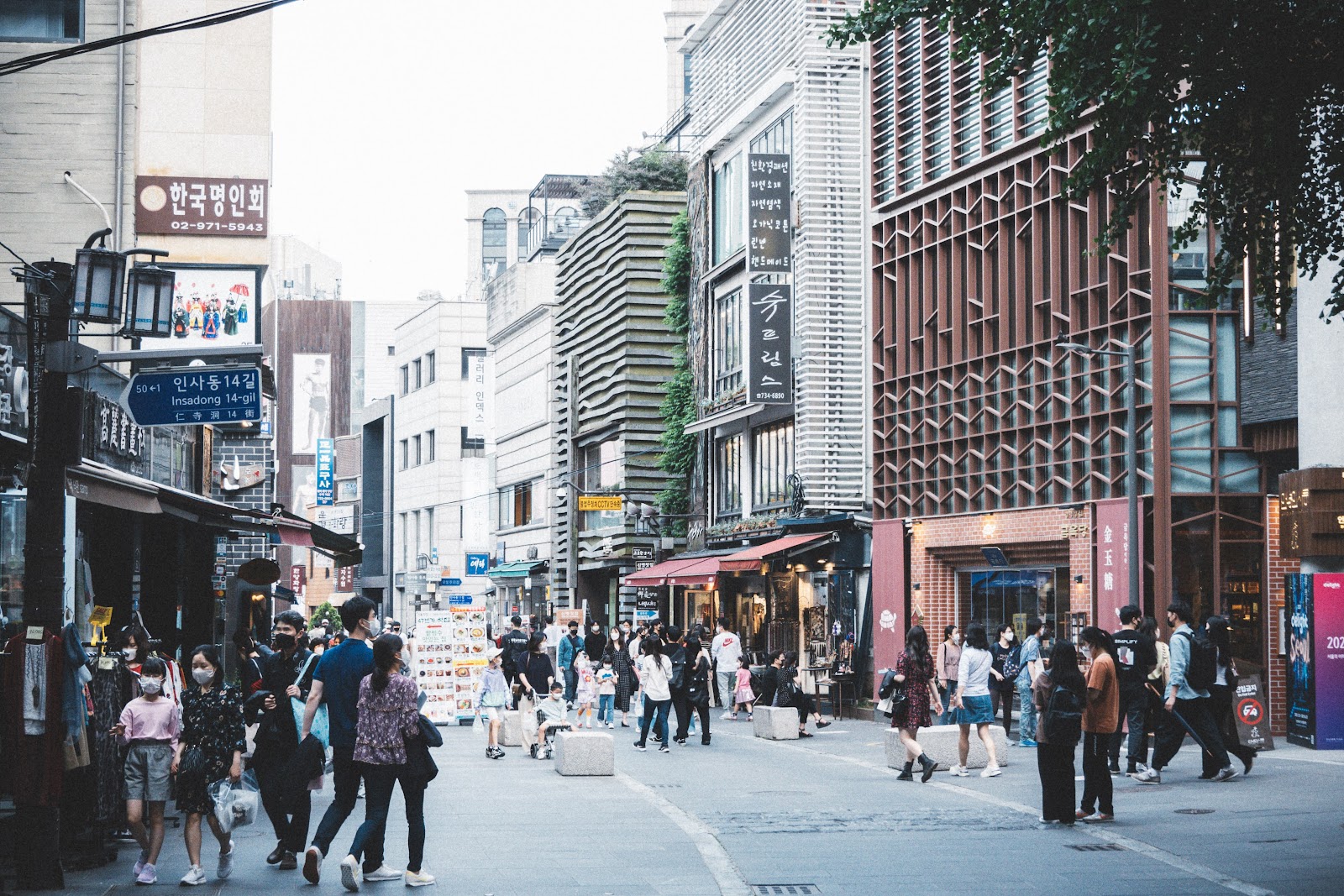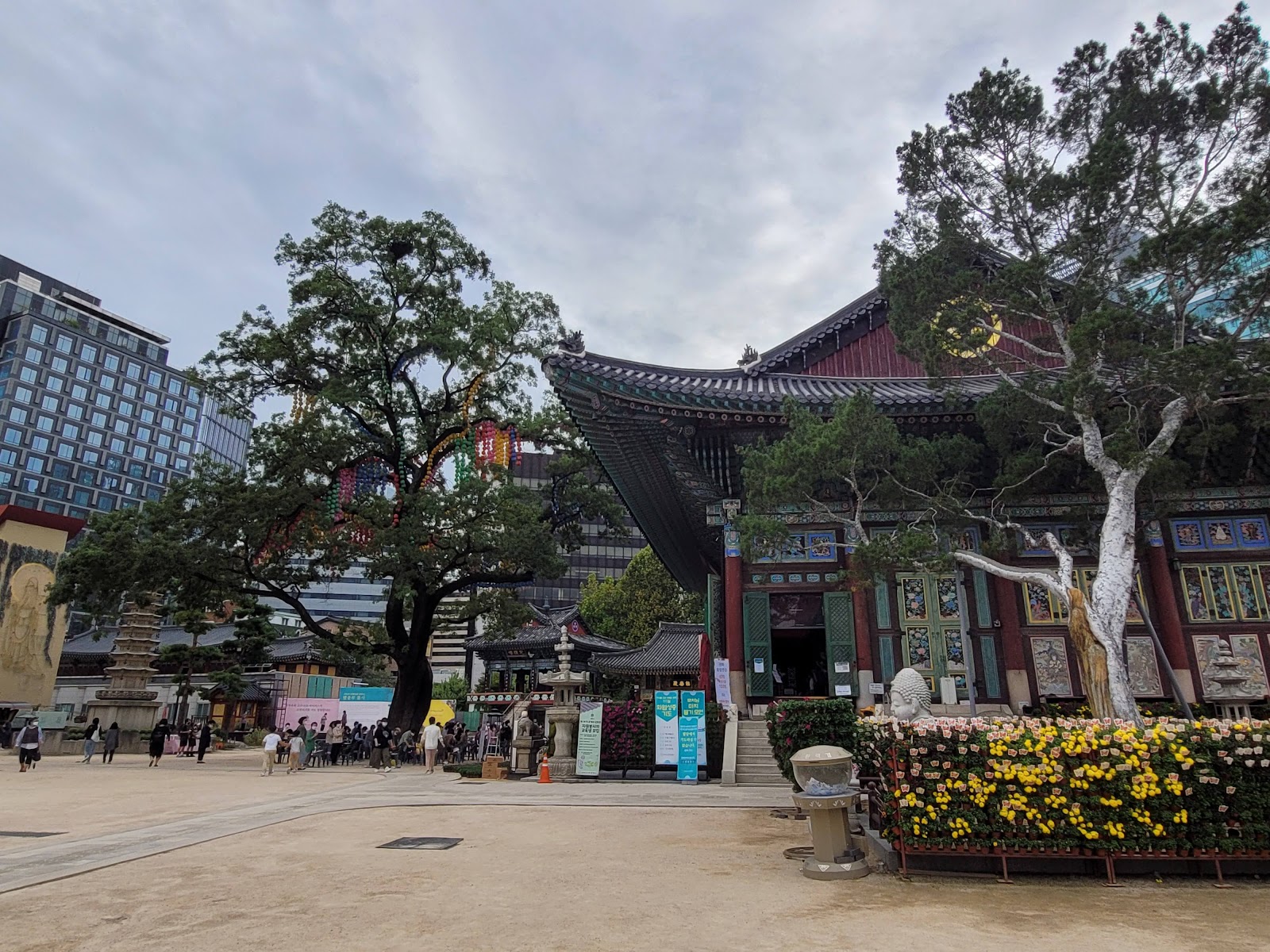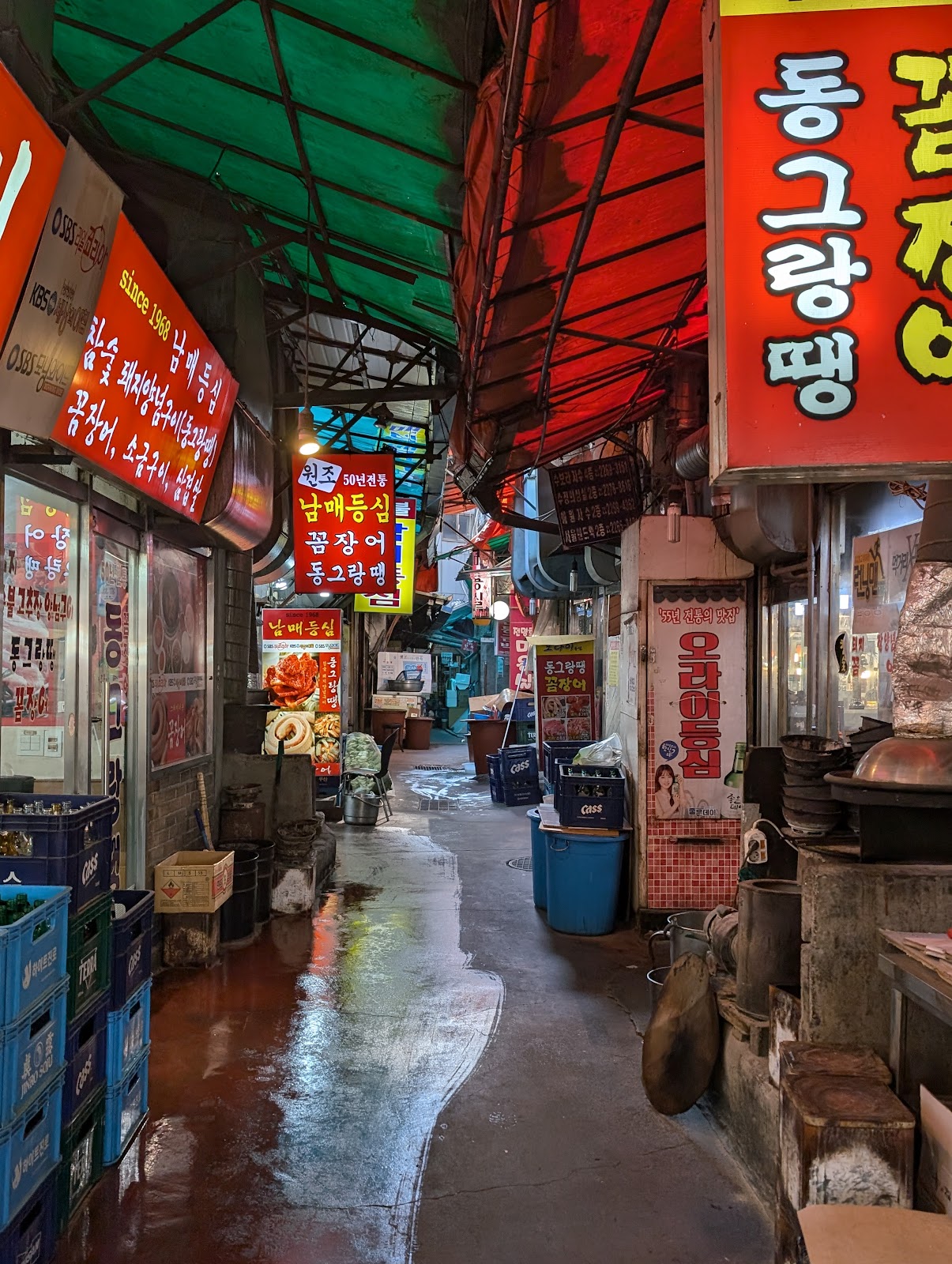Seoul's Hidden Treasures Unveiled
Embark on a captivating adventure through Seoul's rich heritage and vibrant culture on this free walking tour. Discover history at every corner!
Time
3 Hours
Stops
8 Places
Distance
?
Gyeongbokgung Palace
Begin your journey at Gyeongbokgung Palace, the grandest of Seoul's Five Grand Palaces, offering a glimpse into Korea's royal heritage.

Gyeongbokgung Palace (Source: Google Maps)
Gyeongbokgung Palace, the largest of Seoul's Five Grand Palaces, was built in 1395 during the Joseon Dynasty. This majestic structure served as the main royal palace and is a prime example of traditional Korean architecture, characterized by its elegant wooden buildings and beautiful gardens. The palace complex features the National Palace Museum of Korea and the National Folk Museum of Korea, which provide deeper insights into Korea's royal history and cultural heritage. Visitors can witness the Changing of the Guard ceremony, which takes place at the main gate, Gwanghwamun, showcasing the grandeur of the past. The palace grounds also include serene ponds and landscaped gardens, making it a tranquil escape from the bustling city.
National Folk Museum of Korea
Located within the grounds of Gyeongbokgung Palace, this museum provides insight into traditional Korean life and culture through its extensive exhibits.

National Folk Museum of Korea (Source: Google Maps)
The National Folk Museum of Korea, situated within the grounds of Gyeongbokgung Palace, offers a comprehensive look at the daily lives of ordinary Koreans throughout history. Established in 1945, the museum showcases artifacts, traditional clothing, and dioramas that illustrate various aspects of Korean culture and history. The museum's exhibitions are divided into three main sections: 'The History of Korean Life,' 'The Life of the People,' and 'The Life Cycle.' Each section provides visitors with a unique perspective on the evolution of Korean society, from ancient times to the present. The museum also hosts various cultural events and educational programs, making it a vibrant center for learning about Korea's rich traditions.
Bukchon Hanok Village
Just a short walk from the palace, Bukchon Hanok Village offers a picturesque view of traditional Korean houses amidst the modern cityscape.

Bukchon Hanok Village (Source: Google Maps)
Bukchon Hanok Village is a historic neighborhood located between Gyeongbokgung Palace and Changdeokgung Palace. This area is renowned for its well-preserved hanok, traditional Korean houses that reflect the architectural style of the Joseon Dynasty. Walking through the narrow alleys, visitors can admire the unique charm of these wooden structures, many of which are still inhabited. The village also houses numerous cultural centers, craft workshops, and tea houses, offering a glimpse into traditional Korean life. Bukchon serves not only as a living museum but also as a cultural hub, where visitors can participate in various activities such as hanbok (traditional clothing) wearing experiences and traditional tea ceremonies, making it a must-visit for anyone interested in Korea's heritage.
Changdeokgung Palace
A UNESCO World Heritage Site, Changdeokgung Palace is renowned for its beautiful gardens and well-preserved architecture.

Changdeokgung Palace (Source: Google Maps)
Changdeokgung Palace is a UNESCO World Heritage Site renowned for its beautiful garden and well-preserved architecture. Built in 1405, it served as the primary royal residence during the Joseon Dynasty and is often considered the most beautiful of the Five Grand Palaces. The palace is famous for its Secret Garden, a serene landscape that showcases the harmony between nature and architecture, featuring ponds, pavilions, and walking paths. The layout of Changdeokgung reflects the principles of traditional Korean aesthetics, emphasizing natural beauty and balance. Visitors can explore the palace grounds on guided tours that provide insights into the royal family's life and the historical significance of the site. The architecture, characterized by elegant wooden structures and colorful roofs, exemplifies the artistry of the period.
Insadong Street
Stroll through Insadong, a vibrant cultural district known for its art galleries, traditional tea houses, and unique shops.

Insadong Street (Source: Google Maps)
Insadong Street is a vibrant cultural district in Seoul, known for its rich artistic heritage and traditional crafts. This area is lined with art galleries, antique shops, and traditional tea houses, making it a hub for both locals and tourists. Insadong has been a center for Korean culture for centuries, and today, it continues to showcase the country's artistic brilliance. Visitors can explore the diverse offerings, from calligraphy supplies to handmade pottery, and enjoy street performances that often take place in the area. The street is also famous for its traditional tea houses, where guests can experience Korean tea culture firsthand. Insadong is an essential stop for those looking to immerse themselves in the artistic spirit of Seoul and discover unique souvenirs.
Jogyesa Temple
Walking south from Insadong, you'll find Jogyesa Temple, a serene Buddhist temple that serves as a spiritual center in the heart of Seoul.

Jogyesa Temple (Source: Google Maps)
Jogyesa Temple is the chief temple of the Jogye Order of Korean Buddhism, located in the heart of Seoul. Established in the late 14th century, this temple serves as a spiritual center for many Koreans and is known for its beautiful architecture and serene atmosphere. The temple grounds are adorned with vibrant lanterns, especially during Buddhist festivals, creating a colorful and peaceful environment. The main hall, Daeungjeon, houses a large statue of the Buddha and is a place for worship and meditation. Visitors can participate in various temple programs, including meditation sessions and tea ceremonies, providing a unique opportunity to experience Korean Buddhism. The temple's proximity to Insadong makes it a convenient stop for those exploring the cultural district, offering a tranquil escape from the bustling city.
Cheonggyecheon Stream
Enjoy a peaceful walk along Cheonggyecheon Stream, an urban renewal project that transformed a highway into a tranquil public space.

Cheonggyecheon Stream (Source: Google Maps)
Cheonggyecheon Stream is an urban renewal project that transformed a neglected waterway into a beautiful public space in downtown Seoul. Spanning approximately 11 kilometers, the stream flows through the city, providing a serene escape amidst the urban landscape. The project, completed in 2005, aimed to restore the natural environment and enhance the quality of life for residents and visitors. Along the stream, visitors can enjoy walking paths, art installations, and various recreational facilities. The area is particularly popular for leisurely strolls, picnics, and cultural events. Cheonggyecheon also features several bridges and fountains, adding to its charm. The revitalization of Cheonggyecheon has become a model for urban development, showcasing the importance of integrating nature within the city.
Gwangjang Market
Conclude your tour at Gwangjang Market, one of Korea's oldest traditional markets, where you can experience authentic Korean street food.

Gwangjang Market (Source: Google Maps)
Gwangjang Market is one of Korea's oldest traditional markets, established in 1905, and is famous for its vibrant atmosphere and delicious street food. The market offers a wide variety of goods, including textiles, clothing, and traditional Korean snacks. Visitors can explore numerous food stalls serving popular dishes such as bindaetteok (mung bean pancakes), tteokbokki (spicy rice cakes), and various types of kimchi. Gwangjang Market is not only a culinary destination but also a cultural experience, where visitors can witness the hustle and bustle of daily life in Seoul. The market has retained its traditional charm, making it a perfect place to experience authentic Korean culture. Visitors often come to sample the diverse offerings and enjoy the lively ambiance, making it a must-visit for food enthusiasts.

Your travels, your rules.
Create your own Free Walking Tours.
Set your preferences, distances and anything you want to do or see.
Completely free, no payment required.